Tips:
- Use a sharp knife or herb scissors when chopping fresh herbs so they cut rather than crush the delicate herb leaves. Crushing leads to bruised, blackened herbs. If you'd like to use fresh herbs instead of dried herbs in a recipe, add 3-4 times more fresh herbs than the recipe calls for and add it in at the end.
- Super how-to from my Grandma: deep freeze your fresh herbs. Chop up fresh herbs and pop them into an ice cube tray, add salt and freeze for later use. Try freezing them in olive oil for use in sautés or roasted dishes!
Fresh herbs will give your dishes a distinctive aliveness. They will add a sunny and perfumed character as well as color and a professional finish. Even if you don't use fresh herbs in your everyday cooking, indulge the taste buds of your party guests. Herbs are the greatest joy to use - nature's gift to cooks.
If you liked this short guide and got inspired – let me know! Also, I would like to know about your favorite fresh herbs in the kitchen!
See you soon!
Here is the second part of my short guide of fresh herbs. With a few tips and tricks you can maximize your use of fresh herbs to transform every meal into something special.

A friend of mine has a magnificent herb garden, where she grows a huge range of herbs, and her knowledge of herbs is extensive. Over the years she shared her experience with me, and now I have my own little garden with fresh herbs at home. Of course, not everyone has the desire, or space, to grow the own garden, but you’ll probably get inspired to grow just a few herbs, such as rosemary or sage, to use in our cooking. And I am glad to give you an insight into some of my favorite herbs that can be used in the kitchen. Hope you will find this information useful!
Borage

Refreshing and beautiful, borage is an underrated culinary herb. The whole plant has a cucumber odor and flavor. Borage’s cucumber flavor makes it a logical addition to any green salad, but be sure to cut the leaves up small enough to negate the hairiness. Add the cut up leaves to cream and cottage cheese and put into herb sandwiches with a little salt and pepper. They are also tasty on grilled onions sprinkled with balsamic vinegar. Borage is also great for summer lemonades.
Borage reduces stress, protects heart health, and prevents chronic diseases. Rich in gamma-linolenic acid, stearic acid and other antioxidants.
Parsley

Because of its light scent and fresh taste, parsley can be used in anything from soups to sauces to vegetables. In Middle Eastern cuisine, parsley is one of the main ingredients in dishes such as tabbouleh, a salad using bulgur, mint, parsley, and vegetables, and is the main herb used in stuffing for grape leaves.
Parsley is particularly rich in flavonoid antioxidants and vitamin C, which reduce oxidative stress in your body and may lower your risk of certain cancers.
Chives

The taste of chives is generally considered to have a mild, pleasant flavor that is subtle in culinary applications. In terms of culinary appeal, the flavor of chives is considerably milder than onion or garlic. The herb is used fresh or dried (as well as the flowers) to flavor vinegars, often in combination with other herbs. Dried chives are excellent additions to soups and salads, as well as dips, soft cheeses and herbal butters.
Chives boost heart and bone health, protects against cancer, improves immunity. Rich in lutein, folic acid, vitamin K, potassium, and zinc.
Estragon (Tarragon)

Estragon’s flavor diffuses rapidly through cooked dishes, so use it carefully. Use it fresh with fish and shellfish, turkey, chicken, game, veal and egg dishes. Use chopped leaves in salad dressings, mustard and bechamel sauces, sauce verte and mayonnaise. Oil of tarragon is used in salad dressings and summer lemonades.
Estragon helps to reduce blood sugar level, relieves headaches, improves sleep. Rich in protein, magnesium, zinc, calcium and iron.
Mint

Lovely though its flavor is, fresh mint can overwhelm milder flavors and is best used with a light hand. Dried mint is less assertive and is favored in Mediterranean and Arab countries. In general, mint does not complement other herbs well, except parsley, thyme, marjoram, sage, oregano and coriander. It goes well with yogurt, and is used for roast lamb, potatoes, peas and salads. Peppermint has a particularly strong flavor and aroma. It makes a pleasant digestive tea, and is also used in ice creams.
Peppermint is a good source of manganese, copper and vitamin C. Mint also contains vitamins and minerals including vitamins A, B-6, C, E, and K, beta carotene, folate and riboflavin and the minerals calcium, iron, potassium, magnesium and manganese. Fresh mint is a powerful antioxidant.
Thyme

Thyme is used for adding layers of flavor without being overwhelming. It's commonly used to season soups, sauces, and braises. It also makes a welcome addition in potatoes, rice dishes, vegetables and even fresh bread.
The aromatic flavor of thyme complements Southern Italian sauces of hot peppers and eggplants, thyme is also a popular seasoning for lamb, stews, rice dishes, dips, and sauces.
Thyme strengthens the immune system, prevents cold. Rich in vitamins C and A, fiber, iron, and manganese.
Oregano

Oregano is a versatile and robust herb that comes in whole leaves or ground up, giving meals a peppery bite and a sweet, minty aroma. Exquisitely aromatic, oregano offers much more than culinary uses. Pair with tomatoes, garlic, olive oil, oregano, pasta, onions, chicken, eggs, pizza, green leaf salads, and almost any Italian dish.
Oregano is a good source of vitamin B6, potassium and copper, and a very good source of dietary fiber, vitamin A, vitamin C, vitamin E (Alpha Tocopherol), vitamin K, Folate, Calcium, Iron, Magnesium and Manganese.
Melissa (or Lemon balm)

The herb is rarely used in cooking, and is more commonly used for its delicate fragrance. However, it makes a great accompaniment to a variety of dishes and also makes a delicious and refreshing tea. Melissa's leaves are a great addition to fruit or vegetable salads.
Melissa relieves insomnia, hypertension, migraine, anxiety, and diabetes.
It is rich in thiamine, riboflavin, vitamin B6, folate, and magnesium.









